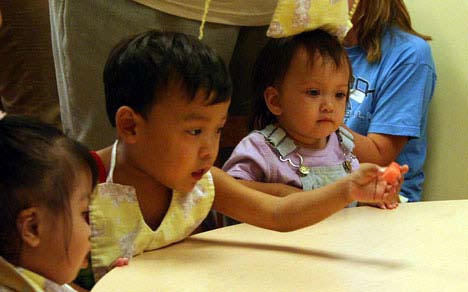
As a parent, teacher or early childhood professional, teaching new skills that will help your child build independence and move forward in their development is important. This can also help to reduce your child’s frustration, promote self-esteem, and to replace behaviour that may not be the most acceptable.
For example, Abdi has difficulties he has at lunch time. Abdi grabs food from other children’s plates. He is using problem behaviour to tell us, “I want some more food”. In fact we learned that Abdi grabs specific food items from others including: bread, crackers, and bananas.
If you have a child like Abdi, you too can teach him to request food more appropriately by using words. Remember that teaching an alternative skill to replace problem behaviour means the new skill must take less energy than the behaviour itself.
In our example, Abdi grabs food from others, so we’ll start by teaching him to use a picture symbol representing the desired item and gradually work towards him being able to use words to make a request.
Breaking Down the Task
Though some children quickly learn skills through observing and imitating others, many children need the new skill to be broken down into smaller steps and to be allowed time to master each step in the sequence. The breaking down of complex skills into smaller components is called task analysis. Anything we do can be broken down into smaller steps. The number of steps depends on the needs of the child.
So how do we break down the task of using a picture symbol (that represents the desired food item) to ask for more food?
- Scan the placemat and locate the picture symbol.
- Touch the picture symbol with hand (or finger).
- Wait for the presentation of the item.
Teaching the New Skill
Teaching a new skill involves preparation. When you are teaching a new skill, consider using photos or pictures symbols that represent each step. In some cases visual supports help your child to understand what is expected of them or can be used to teach him to communicate with others.
As mentioned earlier, we are going to teach Abdi to request a food item first by using pictures and then using words. We’ll start by presenting the picture symbol of bread at every mealtime. By labelling it and pairing it with real bread we want Abdi to understand what the picture represents. We can do this by having both items next to each other and say, “Look, bread (point to real bread) and bread (point to picture symbol)”.
In order for your child to learn the steps to a new skill, you will have to provide assistance or “prompt” along the way. A prompt is a cue or hint meant to help him to perform a desired behaviour, skill, or part of a skill.
In our example, we will start by giving Abdi a positional prompt – this means we will position the bread picture symbol within his view to cue the action of touching it. We will have his hand directly above the picture symbol (located on his placemat), let his hand drop and immediately reinforce him with the food item – a piece of bread. We’ll do this at every meal time and gradually reduce the amount of support until he is able to request independently – this is called fading.
With repeated practice requesting bread using picture symbols, Abdi will be exposed to verbal modelling. After he can successfully request with the picture symbol we’ll change the task and our expectations a bit. Abdi will touch the picture; we will label it (say “bread”), pause and wait for him to make any sound. This is where shaping comes in.
Giving Reinforcement
Reinforcement is anything that motivates or encourages a child. It is any environmental event that maintains or strengthens an action or behaviour. Praise, a special activity, music, toys and food can be used as reinforcers. Reinforcement is a reward that occurs or is given after a behaviour.
It is important to motivate and reward your child who is learning a new skill. It also helps him to stay on track and understand what is required or expected of them.
With Abdi, we will immediately reinforce him with a piece of bread as soon as his hand touches the picture symbol – the bread is highly motivating for him. Eventually, we will want Abdi to use words to make a request. As we begin this phase of teaching him to request with words, Abdi will only be reinforced for closer approximations of the word bread.
By rewarding your child for approximating or getting increasingly closer to the steps that we want to see in the end we can shape his behaviour. For example, he may start with the sound “buh” and slowly progress to “bud”, “beadd” and then “bread”. We will immediately reinforce him with a piece of bread and then with verbal praise, “Great Abdi. You said bread!”
Generalizing the New Skill
You will want your child to know that this new skill can be applied in many places, with many people, and under many conditions. For some children, learning to request for more food at the child care centre does not necessarily mean that they are going to demonstrate this skill at home, or with anyone other than the care provider who taught them.
To help your child generalize this skill work in a team as care providers and parents, teaching the same skill in the same way and at different times throughout the day. In time and with patients, your child care learn this valuable skill.
